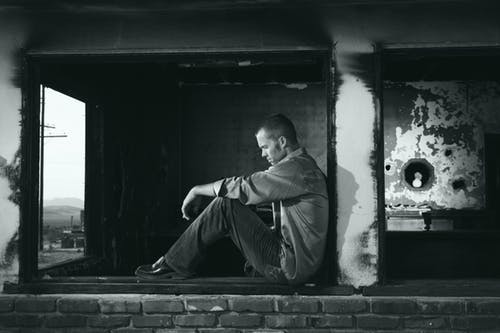Being able to understand and identify the stages of navigating grief can help one cope with it.
Grief occurs as a result of the loss of something that’s valuable to us. It may be the loss of our health, a loved one, a pet, a job, a relationship, anything. Humans display a range of interesting behaviors while experiencing grief.
A popular theory describing the stages of grief was put forward by psychiatrist Elisabeth Kubler-Ross in her book On Death and Dying. She worked with terminally ill patients and observed some common patterns in their behavior.
Later, she noted that the same patterns of behavior could be seen in the relatives of terminally ill patients. She went on to extend her model to grief in general and not just the grief of a person facing imminent death.
It’s from her work that the famous five stages of grief are derived. These five stages are Denial, Anger, Bargaining, Depression and Acceptance.
The five stages of grief are not rigid
The five stages of grief only give us a rough idea of what people tend to experience during moments of grief. These are not well-defined, sequential stages that every grieving person inevitably goes through sequentially as they attempt to cope with their tragedy.
It’s possible that each individual deals with grief uniquely. There are no fixed time intervals or emotional states that people experience in grief. People may go back and forth between these five stages, skip some of them, or not experience some of them at all.
Despite these limitations, the five stages of grief model provides useful insights into how grieving persons behave and why.

1. Denial
Losing something that’s valuable to us can be too much for our minds to take. Our mind is shocked and needs time to process the loss.
Denial is a defense mechanism of the mind that gives it time to process the loss. It’s a visceral reaction to loss- we simply don’t want to believe what has happened.
“This can’t be happening!”
“No! This can’t be true!”
There are two kinds of denial. The first is where a person actually believes that the loss didn’t happen. They talk and behave as if the bad event never happened. This borders on pathological behaviour but the person sooner or later comes to grips with reality. If they don’t, they might need professional help.
The other, more common, type of denial is where a person knows deep down that the unfortunate event happened but doesn’t want to believe it because it’s so painful.
Say someone lost a loved one by death. The grieving person in denial might scream “NO! HE’S NOT DEAD!” and try to shake and wake up the dead person. The dead person not waking up eventually convinces the grieving person that the death is indeed real and denial soon fades away.
Also, it’s easy to confuse denial in the grieving process with an expression of regret where the person is not in denial but acknowledges the loss and regrets it. Whether the denial that a person expresses is a refusal to believe the truth or regret can be gauged from what a person utters after saying “No”:
“No! This can’t be happening!” is denial- a refusal to acknowledge the truth even if, deep down, the person acknowledges the truth.
“No! Why is this happening to me?” conveys explicit acknowledgment of the truth and consequent regret.
2. Anger
Anger is the emotion we feel when our rights are snatched or when we lose something we believe we have a right to possess. Denial cannot, and doesn’t, last very long. After all, the person is trying to deny something that is evident.
When denial dissolves, and the person has had time to fully understand what has happened, they may become angry.
This anger may be directed at anything in the environment. Using the example of the death of a loved one again, the grieving person may get angry at other people, themselves, things (throwing things around), and even the dead person.
When shaking the dead person hasn’t worked, the grieving person becomes frustrated and angry and may start to hit the dead body. After that, the grieving person may break down into tears and be taken away from the body by others present.
This act of aggression toward the dead person is a direct expression of the anger the grieving person feels for having experienced the loss.
Some animals seem to behave in similar ways when they lose a loved one. I’m sure you’ve observed how birds behave when a friend of theirs dies. They gather around the dead bird and make loud, hysteric noises. They make similar noises when they’re fighting with each other so it’s safe to assume that these noises are an expression of anger.
Like humans, animals will also try to shake or move the dead to try and wake them up. This is a way for them to assess if the dead are really dead.
Take a look at this clip of an emperor penguin trying to move her dead baby in hopes that it wakes up:
In the following clip showing chimpanzees grieving the death of a fellow chimp, one chimp suddenly hits the dead chimp hard. The researchers are not sure why the chimp did that strange behaviour. Probably anger directed toward the dead that humans who were closest to the dead display too.
3. Bargaining
Bargaining is an attempt by the grieving person to reverse the loss. They negotiate to get back what they lost. People make promises to themselves, or to the higher power they believe in, that they would longer do that thing which led to the loss.
“If only I had done X differently, this wouldn’t have happened.”
“I swear I’ll become a better parent if I get my son back.”
“I promise I’ll exercise and eat well if I get my health back.”
People have a tendency to blame themselves for their loss. Most of the time people have no control over their losses. But they want to believe they have control. So they’re like “If I only did that differently….”
They overestimate their ability to control what happens to them to give themselves an illusion of control.
At the same time, people are not always wrong when they think like this and things aren’t always entirely out of their control. Their actions could have prevented the loss from happening. For example, exercising and eating well could have reduced a person’s chances of getting sick.
In this case, the guilt is justified, and this guilt motivates them to learn from their mistakes.
Mostly, the guilt people experience because of their loss isn’t justified. They couldn’t have possibly prevented the loss. Realizing this is key to overcoming the guilt that people might experience after a loss.
4. Depression
Common depression symptoms include withdrawal, loss of energy, and a lack of interest in doing the things that the depressed person previously found enjoyable.
In Depression’s Hidden Purpose, I pointed out that depression is a way our mind gives us time to ruminate over a complex life problem so that we can find a solution and pull ourselves out of our mess.
Losing something that’s valuable to us brings grief and depression because our mind sees this loss as a problem that needs to be solved. Depression slows you down so that you can focus your energies on resolving this big issue that you’re facing.
When you’re depressed, you ponder over your loss again and again. Hopelessness is another major symptom of depression. Whilst pondering over your loss, you may conclude that there’s no way you’re going to fix this. That’s when hopelessness sets in.
“What’s the point of it all?”
“Why go on?”
“There’s nothing left to live for.”
If you get depressed when you lose your job, depression can aid you in thinking about how to find another job. But why get depressed over the loss of a loved one, an irreversible phenomenon?
The answer is that you may rationally know the person can’t be brought back, yet the depression response is activated because you unconsciously perceive your loss as a problem. When you get used to the idea that the dead person can no longer be brought back, depression will subside.
5. Acceptance
Acceptance happens when a person is no longer denying, angry at, or trying to reverse or resolve their tragedy. They understand what has happened has happened and that they have to live with it.
This doesn’t mean they’re okay with what happened- they may never really be able to get over the loss. Rather, it means they’ve accepted the event as a part of their life and are ready to move on.
Acceptance also doesn’t mean they’ve forgotten about the loss, just that they’ve learned to deal with it. They’re no longer allowing it to have a major impact on their lives even if the pain lives on in their heart.
Grief and empathy
For a social species like us, grief and empathy go hand in hand. The grieving person receives support, sympathy, and care from others. Nothing unites a group more strongly than grief.
Grief can be thought of as an evolved mechanism that elicits sympathy in one’s group members and enhances group cohesion. Any social species that evolved this mechanism likely had an edge over other species that didn’t.
I’ll sign off by leaving you with perhaps the best nature clips ever filmed. Langur monkeys drop a fake, spy langur and think it’s dead. Then, being the social species they are, they grieve over it in a very human-like manner:
